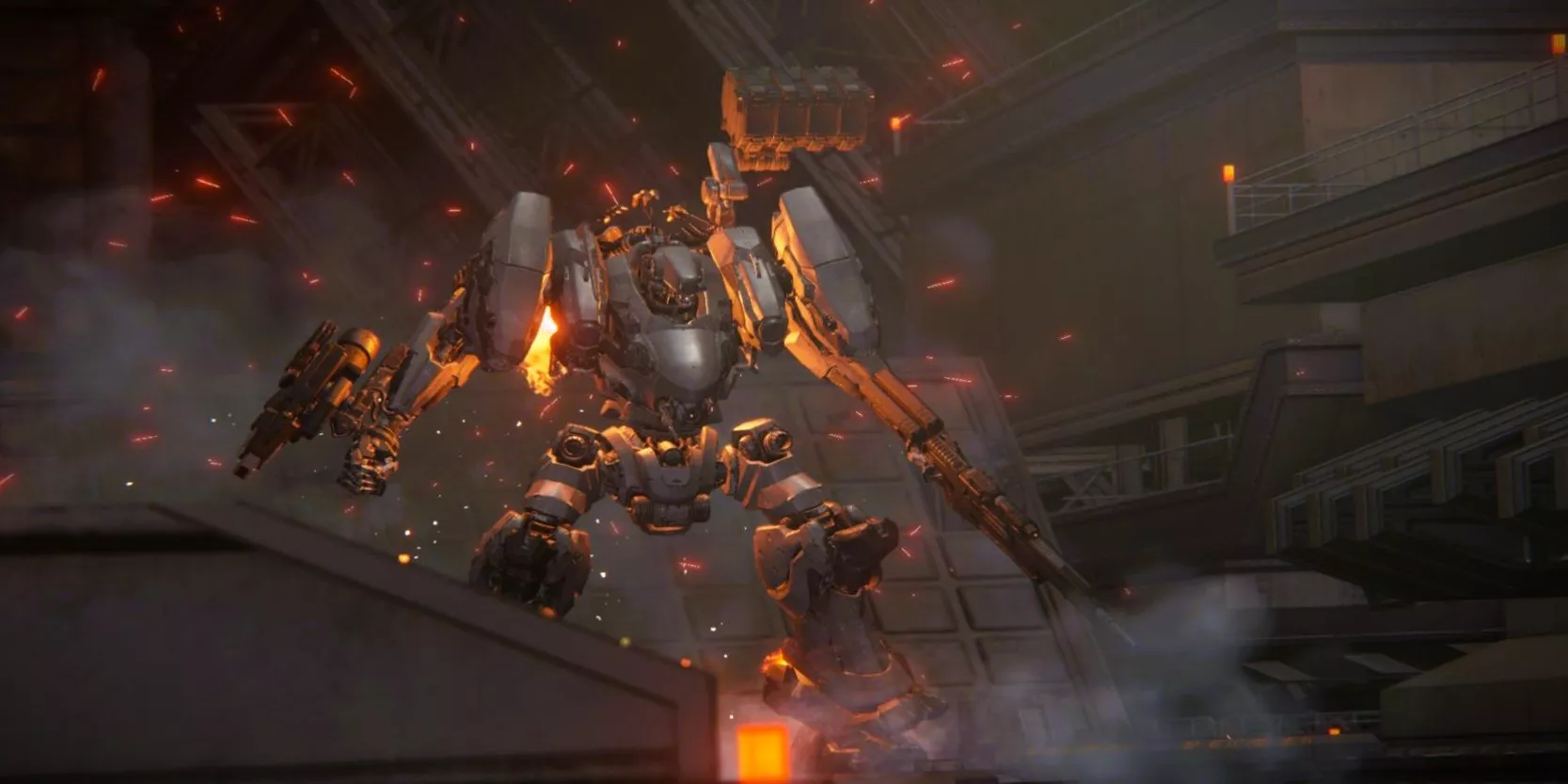Armored Core 6: Fires of Rubicon immediately impresses with its remarkable visual design, explosive effects, and a moderately intricate yet accessible robot-building system. The vehicular combat gameplay loop maintains its entertainment value throughout the game. FromSoftware continues its streak of successful releases, and Armored Core 6 is poised to become a cherished addition to the studio’s acclaimed portfolio. Nonetheless, the game is not devoid of flaws. Unfamiliar players might encounter some challenges in embracing the experience due to specific minor issues, although the overall enjoyment remains steadfast.
One potential challenge may arise not from the game itself, but from a contrast with FromSoftware’s more recent offerings. Having originated with the original Armored Core in 1997, longstanding fans of the series might not grapple with the somewhat peculiar sense of constraint that newcomers might feel, especially if they have become accustomed to the expansive realms of Elden Ring and Sekiro: Shadows Die Twice. The game’s delineated and compartmentalized gameplay zones, demarcated by vivid neon-red boundaries, could be a jarring shift for those anticipating the free exploration of Rubicon’s expanse in their towering mechanical mechs, akin to the protagonists of the aforementioned titles. However, Armored Core 6, following its predecessors’ approach, adheres to a distinct gameplay style. Observing how newcomers adapt to this structure will be intriguing. The core gameplay loop is straightforward: players configure their mech’s armaments and components, embark on and accomplish missions, and subsequently return to the mission selection interface. While this loop is fundamental, the game consistently avoids any sense of wasting players’ time, save for infrequent instances of mission location repetition.
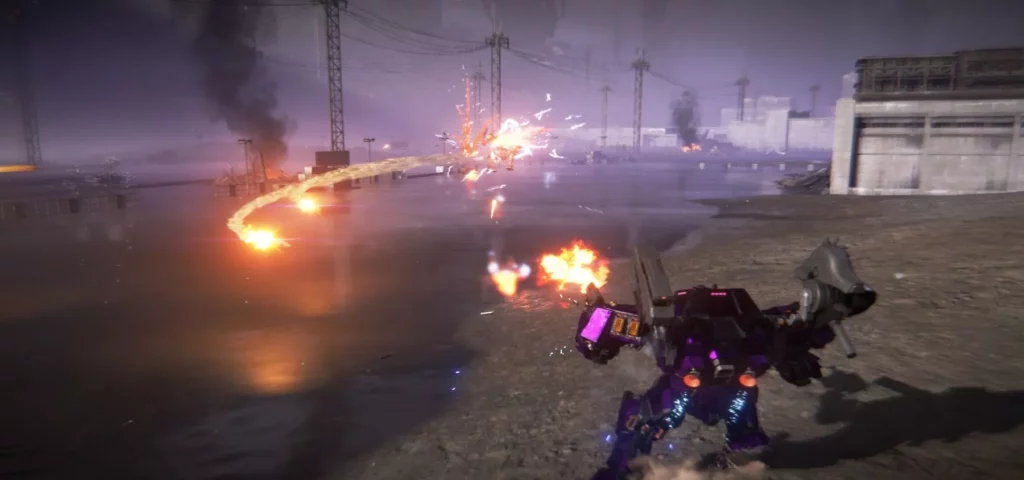
The seamlessness of progressing through multiple missions in a single play session is quite striking. The narrative begins at a measured pace, withholding its ultimate direction until the later stages of the game. It lacks a singular captivating moment that propels players to continue solely for the sake of discovering what unfolds next. Despite this absence, many will find it arduous to put down, a testament to its inherent engagement. The story maintains a steady foundation, albeit somewhat ordinary, yet the game excels in maintaining player interest by virtue of its enjoyable gameplay. It’s important to note that certain missions will undoubtedly leave a more lasting impression than others.
The most luminous instances arise at the culmination of chapters, primarily due to their diverse action sequences and their role in advancing the narrative. Some even commence with unexpected twists. Mission types also exhibit a fascinating range, although most entail some form of destruction. While some involve straightforward one-on-one battles, others immerse players in subterranean caverns to salvage damaged mechs, while yet others prompt assaults on fortified bases. Armored Core 6 presents a commendable spectrum of activities, even though the overarching focus remains on dismantling adversaries. The developers wisely introduced the option to replay completed missions for the purpose of accumulating funds necessary for weapon and armor upgrades. This strategic move alleviates the frustration of feeling stuck when confronted with seemingly insurmountable challenges, as revisiting earlier missions can yield sufficient funds for essential enhancements.
The portrayal of environmental destruction fluctuates in effectiveness. Minor obstructions like lampposts, railings, and cars disintegrate upon impact, while larger elements like sizable fuel tanks detonate when struck. However, the majority of structures, both substantial and petite, remain impervious to destruction. This design choice aligns with gameplay requirements, as cover proves indispensable for successful mission completion. Nonetheless, a certain dissatisfaction arises from the absence of comprehensive devastation, particularly when controlling a nimble and formidable mechanical marvel. It could be argued that a sensation of missed opportunity permeates the experience. However, the game still boasts incredible facets. Armored Core 6 delivers a spectacle of captivating explosions, ranging from the miniature bursts as small tanks are obliterated to the grand detonations stemming from bosses and massive vehicles—a visual feast. Even the trails of smoke from missiles and the residual traces of grenade launches or electric sniper shots offer a visually pleasing spectacle. Enthusiasts of visually stunning combat will undoubtedly relish the abundance of offerings within this game.
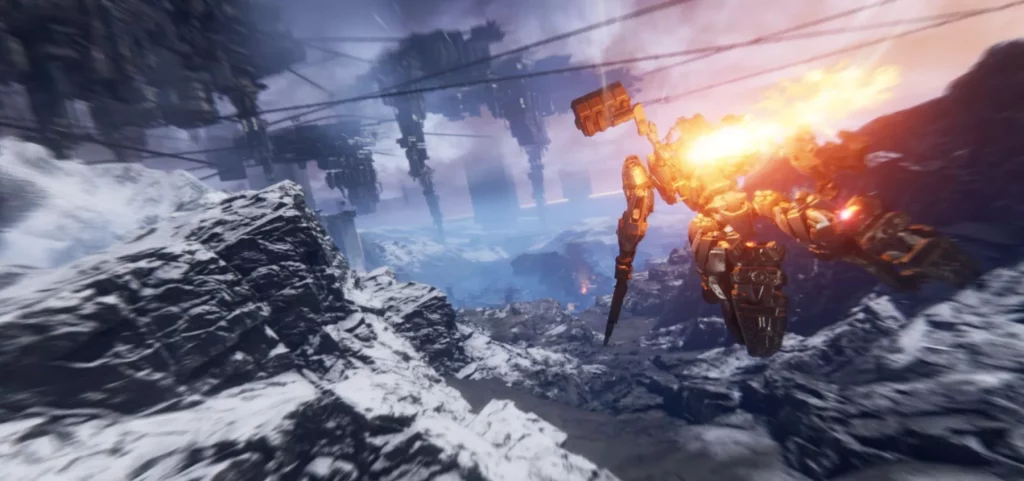
However, it’s worth noting that certain terrain graphics exhibit a degree of simplicity, although the challenge of rendering visually appealing snow and mud shouldn’t be underestimated. While not subpar by any means, these graphics lack the capacity to evoke the same sense of awe as the explosions and combat visuals do. For most, the understated nature of the diverse locations across Rubicon might escape notice, but for a few, the game’s terrain could prove a source of disappointment. Fortunately, the game avoids positioning the terrain as its primary focal point. In a game centered around colossal mechanical robots engaged in combat, the true protagonists undeniably remain these very robots.
FromSoftware has invested significant effort into crafting a diverse array of captivating mech designs. Divided into distinct components—head, torso, legs, arms, and weaponry—each element can be mixed and matched to a certain extent. Every brand boasts its own distinct style, ranging from robust and bulky to sleek and pointed, and each imparts its own advantages and drawbacks in terms of weight and a plethora of other statistics. While overarching limitations based on total weight and the mech’s internal systems exist, ample freedom is still granted for players to devise their own towering machines. Users can devise a long-range sniping behemoth mounted on tank treads, specializing in distant eliminations, or a swift and nimble close-quarters combatant equipped with an assortment of saws and energy blades for up-close dismemberment.
Armored Core 6 thrives on player agency, although certain missions may incline more heavily toward a particular direction in terms of what priorities must be embraced for success. A few missions can appear nearly insurmountable for a melee-focused build due to the rapid accumulation of damage if players aren’t cautious. Overcoming these challenges can be achieved through practice and determination or by modifying the mech’s configuration at the mission restart interface, enabling players to reposition components and swap out weaponry they’ve already acquired. This welcomed feature facilitates extensive trial and error without necessitating the repetition of substantial portions of missions.
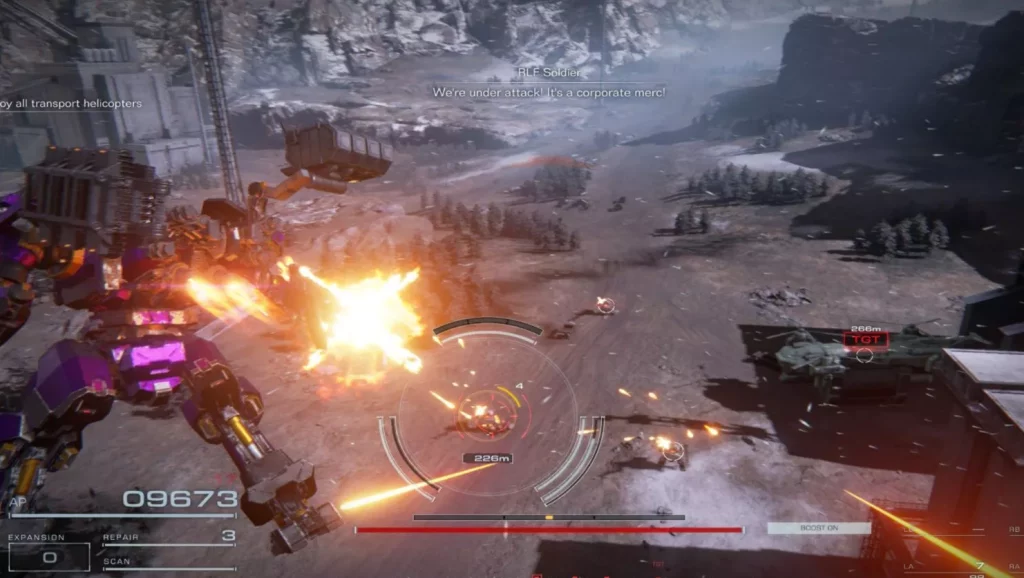
A plethora of weapons await selection as well. All the typical armaments are at one’s disposal: machine guns, submachine guns, grenade launchers, rockets, cannons, electric-based firearms—virtually anything a player could wish to affix to a massive mech. Visually impressive and possessing some of the vehicular combat genre’s most exceptional effects, these weapons excel. However, a slight dip in enjoyment arises from the fact that certain weapons are intended to be substituted with superior armament that becomes available as the player advances. This might entail bidding farewell to a cherished sounding or enjoyable-to-fire weapon, especially when the necessity arises for rapid damage infliction. The quandary escalates when it comes to replacing mech components, as specific parts offer augmented health and/or defense, compelling players to trade out their favored aesthetic pieces. Fortunately, paint schemes and decals are automatically transferred to the new armor or weaponry, and some fresh components might even outshine the old ones after installation.
This upgrade system also blurs the boundaries of the game’s difficulty. During the review playthrough, much of the game proved manageable, with the principal challenges chiefly arising from end-of-chapter bosses, particularly in the initial chapters. The smoother stretches almost detached the experience from the usual FromSoftware formula, yet the developers were resolute in reiterating their prowess in boss design and their capacity to swiftly amplify the difficulty. The shift is quite pronounced, transitioning from breezing through missions with minimal apprehension to colliding head-on with an imposing obstacle that halts the player in their tracks, culminating in a fiery demise. The interpretation of such obstacles could significantly shape one’s overall enjoyment of the game.
Above all, Armored Core VI commends tenacity. As with many other FromSoftware titles, there’s a unique sensation tied to conquering something that initially appears insurmountable after several attempts. This constitutes a brilliant aspect of numerous FromSoftware games: arming players with the tools of repetition and strategic adjustments that enable them to scale the wall of adversity and emerge on the other side imbued with a sense of accomplishment, bolstered by visual evidence of their triumph.
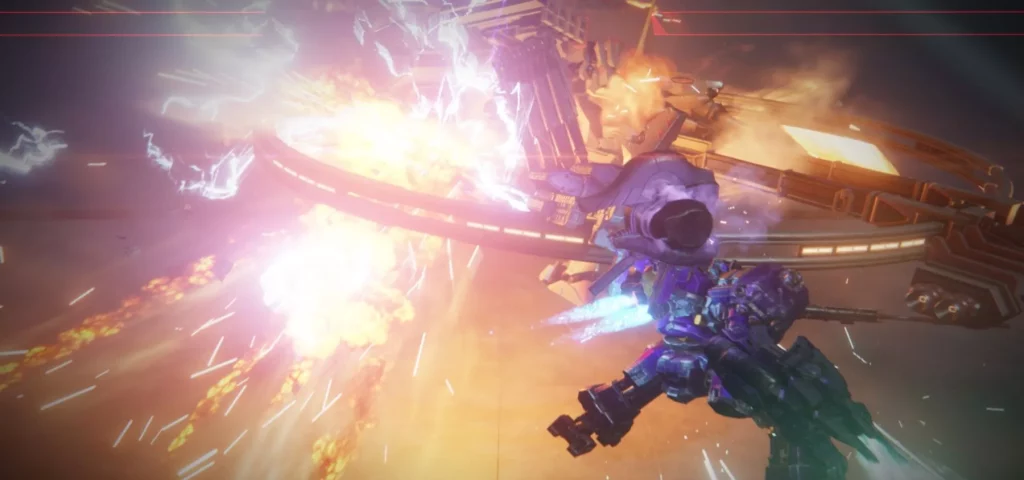
For players seeking a respite from the main storyline, an additional avenue is available: a 1 vs. 1 arena mode where they can engage digital iterations of both adversarial and amicable NPCs encountered throughout the game. Each opponent bears a letter ranking, and players are tasked with ascending the ranks of mercenaries to not only acquire their adversaries’ emblems but also collect items known as OST chips. These chips serve as a means to directly enhance various aspects of a player’s statistics, such as augmenting explosive damage or incorporating specialized armor activatable via a keystroke. This feature also influences gameplay builds, as augmenting specific damage types inevitably shapes the selection of weapons brought into battle. While an optimal array of choices may eventually surface as superior, in the initial stages, prioritizing damage augmentation often seems the wisest course of action. This adds an additional layer to the game without undue complexity, ensuring that it doesn’t convolute the gameplay experience.
All these choices and enhancements can be translated to the multiplayer arena. A maximum of nine players can occupy a single room, with two current formats available: the 1v1 Single mode or the 3v3 Battle mode, pitting participants against both AI and human adversaries. The host has the discretion to determine whether the victors or the defeated sit out the subsequent match, thus enabling rotation among those who haven’t yet taken part. The pandemonium induced by facing off against human opponents is genuinely enthralling.
While the game’s enemy AI holds its ground commendably, a unique blend of trepidation and fascination can only be savored in contests against fellow players. The amalgamation of diverse weaponry, mech designs, and ensuing chaos forms an intensely captivating cocktail. Players also possess the capability to upload their loadouts and disseminate them online among friends and rivals, serving as a reference point for evaluation or emulation. This feature offers an excellent starting point for users unsure about which direction to take when crafting their mech. The absence of varied multiplayer modes might hinder its ascension to the game’s primary attraction, but it’s certain that players will clamor for more in the months following the game’s launch.
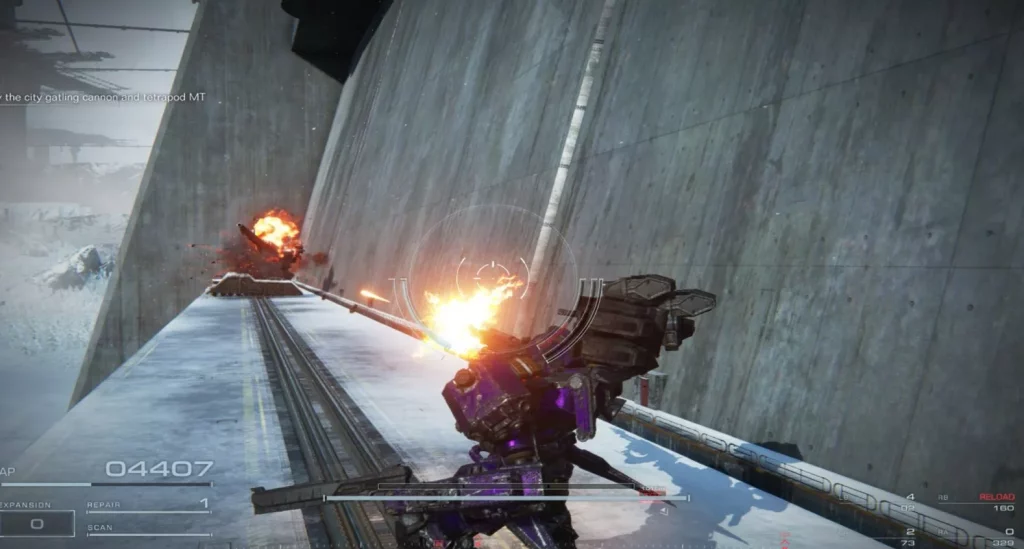
From Software has dedicated its efforts to crafting an exceptional vehicular combat game, rooted in the franchise’s foundations while introducing an awe-inspiring element for newcomers to the genre. The game’s velocity, customization possibilities, and engaging gameplay loop are poised to attract enthusiasts from all corners of the globe, luring them into a realm of frenetic combat and destruction. The single-player campaign adeptly underscores FromSoftware’s storytelling prowess, while the multiplayer component, though somewhat streamlined, effectively showcases the exhilaration and enjoyment of pitting oneself against fellow players. Armored Core VI: The Fires of Rubicon is bound to establish itself as the definitive vehicular combat experience for numerous fans, with most pilots finding it nearly impossible to disengage from their mechs and set the game aside for an extended period.
